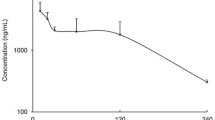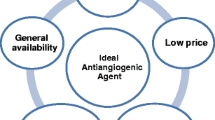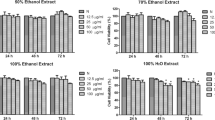Abstract
Background
Curcumin is a small-molecular-weight compound that is isolated from the commonly used spice turmeric. In animal models, curcumin and its derivatives have been shown to inhibit the progression of chemically induced colon and skin cancers. The genetic changes in carcinogenesis in these organs involve different genes, but curcumin is effective in preventing carcinogenesis in both organs. A possible explanation for this finding is that curcumin may inhibit angiogenesis.
Materials and Methods
Curcumin was tested for its ability to inhibit the proliferation of primary endothelial cells in the presence and absence of basic fibroblast growth factor (bFGF), as well as its ability to inhibit proliferation of an immortalized endothelial cell line. Curcumin and its derivatives were subsequently tested for their ability to inhibit bFGF-induced corneal neovascularization in the mouse cornea. Finally, curcumin was tested for its ability to inhibit phorbol ester-stimulated vascular endothelial growth factor (VEGF) mRNA production.
Results
Curcumin effectively inhibited endothelial cell proliferation in a dose-dependent manner. Curcumin and its derivatives demonstrated significant inhibition of bFGF-mediated corneal neovascularization in the mouse. Curcumin had no effect on phorbol ester-stimulated VEGF production.
Conclusions
These results indicate that curcumin has direct antiangiogenic activity in vitro and in vivo. The activity of curcumin in inhibiting carcinogenesis in diverse organs such as the skin and colon may be mediated in part through angiogenesis inhibition.




Similar content being viewed by others
References
Ammon HP, Wahl MA. (1991) Pharmacology of curcuma longa. Planta Med. 57: 1–7.
Stoner GD, Mukhtar H. Polyphenols as cancer chemopreventive agents. (1995) J. Cell. Biochem. Suppl. 22: 169–180.
Huang MT, Lou YR, Ma W, Newmark HL, Reuhl KR, Conney AR. (1994) Inhibitory effects of dietary curcumin on forestomach, duodenal, and colon carcinogenesis in mice. Cancer Res. 54: 5841–5847.
Rao CV, Rivenson A, Simi B, Reddy BS. (1995) Chemprovention of colon carcinogenesis by dietary curcumin, a naturally occurring plant phenolic compound. Cancer Res. 55: 259–266.
Conney AH, Lysz T, Ferraro T, Abidi TF, Manchand PS, Laskin JD, Huang MT. (1991) Inhibitory effect of curcumin and some related dietary components on tumor promotion and arachidonic acid metabolism in mouse skin. Adv. Enzyme Regul. 31: 385–396.
Huang MT, Ma W, Lu YP, Chang RL, Fisher C, Manchand PS, Newmark HL, Conney AH. (1995) Effects of curcumin, demethoxycurcumin, bisdemethoxycurcumin, and tetrahydrocurcumin on 12-O-tetradecanoylphorbol-13-acetate-induced tumor promotion. Carcinogenesis 16: 2493–2497.
Huang MT, Deschner EE, Newmark HL, Wang ZY, Ferraro TA, Conney AH. (1992) Effect of dietary curcumin and ascorbyl palmitate on azoxymethanol-induced colonic epithelial cell proliferation and focal areas of dysplasia. Cancer Lett. 64: 117–121.
Lu YP, Chang RL, Lou YR, Huang MT, Newmark HL, Reuhl K, Conney AH. (1994) Effect of curcumin on 12-O-tetradecanoylphorbol-13-acetateand ultraviolet B light-induced expression of c-jun and c-fos in JB6 cells and in mouse epidermis. Carcinogenesis 15: 2363–2370.
Singh S, Aggarwal BB. (1995) Activation of transcription factor NF-kappa B is suppressed by curcumin. J. Biol. Chem. 270: 24995–25000.
Huang TS, Lee SC, Lin JK. (1991) Suppression of c-jun/AP-1 activation by an inhibitor of tumor promotion in mouse fibroblast cells. Proc. Natl. Acad. Sci. U.S.A. 88: 5292–5296.
Korutla L, Cheung JY, Mendelsohn J, Kumar R. (1995) Inhibition of ligand-induced activation of epidermal growth factor receptor tyrosine phosphorylation by curcumin. Carcinogenesis 16: 1741–1745.
Rao CV, Simi B, Reddy BS. (1993) Inhibition by dietary curcumin of azoxymethanol-induced ornithine decarboxylase, tyrosine protein kinase, arachidonic acid metabolism and aberrant crypt foci formation in the rat colon. Carcinogenesis 14: 2219–2225.
Dietrich WF, Lander ES, Smith JS, Moser AR, Gould KA, Luongo C, Borenstein M, Dove W. (1993) Genetic identification of Mom-1, a major modifier locus affecting Min-induced intestinal neoplasia in the mouse. Cell 75: 631–639.
Su LK, Kinzler KW, Vogelstein B, Preisinger AC, Moser AR, Luongo C, Gould KA, Dove WF. (1992) Multiple intestinal neoplasia caused by a mutation in the murine homolog of the APC gene. Science 256: 668–670.
MacPhee M, Chepenik KP, Liddell RA, Nelson KK, Siracusa LD, Buchberg AM. (1995) The secretory phospholipase A2 gene is a candidate for the Mom1 locus, a major modifier of ApcMin induced intestinal neoplasia. Cell 81: 957–966.
Oshima M, Dinchuk JE, Kargman SL, Oshima H, Hancock B, Kwong E, Trzaskos JM, Evans JF, Taketo MM. (1996) Suppression of intestinal polyposis in Apc delta716 knockout mice by inhibition of cyclooxygenase 2. Cell 87: 803–809.
Hinds PW, Finlay CA, Quartin RS, Baker SJ, Fearon ER, Vogelstein B, Levine AJ. (1990) Mutant p53 clones from human colon carcinomas cooperate with ras in transforming primary rat cells: a comparison of the “hot spot” mutant phenotypes. Cell Growth Differ. 1: 571–580.
Redston MS, Papadopoulos N, Caldas C, Kinzler KW, Kern SE. (1995) Common occurrence of APC and K-ras gene mutations in the spectrum of colitis-induced neoplasias. Gastroenterology 108: 383–392.
Folkman J, Haudenschild C, Zetter BR. (1979) Long-term culture of capillary endothelial cells. Proc. Natl. Acad. Sci. U.S.A. 76: 5217–5221.
Arbiser JL, Moses MA, Fernandez CA, Ghiso N, Cao Y, Klauber N, Frank D, Brownlee M, Flynn E, Parangi S, Byers HR, Folkman J. (1997) Oncogenic H-ras stimulates tumor angiogenesis by two distinct pathways. Proc. Natl. Acad. Sci. U.S.A. 94: 861–866.
Kenyon BM, Voest EE, Flynn E, Folkman J, D’Amato RJ. (1996) A model of angiogenesis in the mouse cornea. Invest. Opthalmol. Vis. Sci. 37: 1625–1632.
Boukamp P, Petrussevska RT, Breitkreutz D, Hornung J, Markham A, Fusenig NE. (1988) Normal keratinization in a spontaneously immortalized aneuploid human keratinocyte cell line. J. Cell Biol. 106: 761–767.
Hod Y. (1992) A simplified ribonuclease protection assay. Biotechniques 13: 852–853.
Prochaska HJ, Santamaria AB, Talalay P. (1992) Rapid detection of inducers of enzymes that protect against carcinogens. Proc. Natl. Acad. Sci. U.S.A. 89: 2394–2398.
Kent KC, Mii S, Harrington EO, Chang JD, Mallette S, Ware JA. (1995) Requirement for protein kinase C activation in basic fibroblast growth factor-induced human endothelial cell proliferation. Circ. Res. 77: 231–238.
Ravindranath V, Chandrasekhara N. (1981) In vitro studies on the intestinal absorption of curcumin in rats. Toxicology 20: 251–257.
Wahlstrom B, Blennow G. (1978) A study on the fate of curcumin in the rat. Acta Pharmacol. Toxicol. 43: 86–92.
Arbiser JL. (1997) Antiangiogenic therapy and dermatology: a review. Drugs Today 33: 687–696.
Kim KJ, Li B, Winer J, Armanini M, Gillett N, Phillips HS, Ferrara N. (1993) Inhibition of vascular endothelial growth factor-induced angiogenesis suppresses tumour growth in vivo. Nature 362: 841–844.
O’Reilly MS, Holmgren L, Shing Y, Rosenthal RA, Moses M, Cao Y, Sage EH, Folkman J. (1994) Angiostatin: a novel angiogenesis inhibitor that mediates the suppression of metastases by a Lewis lung carcinoma. Cell 79: 315–328.
Gess B, Sandner P, Kurtz A. (1996) Differential effects of kinase inhibitors on erythropoietin and vascular endothelial growth factor gene expression in rat hepatocytes. Pflugers Arch. 432: 426–432.
Larcher F, Robles AI, Duran H, Murillas R, Quintanilla M, Cano A, Conti CJ, Jorcano JL. (1996) Upregulation of vascular endothelial growth factor/vascular permeability factor in mouse skin carcinogenesis correlates with malignant progression state and activated H-ras expression levels. Cancer Res. 56: 5391–5396.
Kohl NE, Omer CA, Conner MW, et al. (1995) Inhibition of farnesyltransferase induces regression of mammary and salivary carcinomas in ras transgenic mice. Nature Med. 1: 792–797.
Fahey JW, Zhang Y, Talalay P. (1997) Broccoli sprouts: an exceptionally rich source of inducers of enzymes that protect against chemical carcinogens. Proc. Natl. Acad. Sci. U.S.A. 94: 10367–10372.
Fotsis T, Pepper M, Adlercreutz H, Fleischmann G, Hase T, Montesano R, Schweigerer L. (1993) Genistein, a dietary-derived inhibitor of in vitro angiogenesis. Proc. Natl. Acad. Sci. U.S.A. 90: 2690–2694.
Acknowledgments
J. L. A. was supported by NIH grant RO3AR44947 and grants from the Society for Pediatric Dermatology, the Dermatology Foundation, and the Thomas B. Fitzpatrick Research Award from the KAO Corporation. We acknowledge Albena Dinkova-Kostova for her assistance with the quinone reductase assays.
Author information
Authors and Affiliations
Corresponding author
Additional information
Communicated by P. Talalay.
Rights and permissions
About this article
Cite this article
Arbiser, J.L., Klauber, N., Rohan, R. et al. Curcumin Is an In Vivo Inhibitor of Angiogenesis. Mol Med 4, 376–383 (1998). https://doi.org/10.1007/BF03401744
Accepted:
Published:
Issue Date:
DOI: https://doi.org/10.1007/BF03401744




